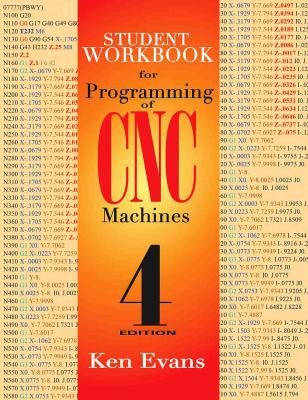ТОП просматриваемых книг сайта:
Student Workbook for Programming of CNC Machines. Ken Evans
Читать онлайн.Название Student Workbook for Programming of CNC Machines
Год выпуска 0
isbn 9780831193812
Автор произведения Ken Evans
Жанр Программы
Издательство Ingram
6. In this example, the material is stainless steel. A .5625 inch diameter hole is to be drilled through a plate that is 1.25 inch thick. Calculate the r/min and feed rate best suited for this operation. Use the HSS end mill values from the chart.
7. A carbon steel plate 4.0 inches square requires a 2.0 inch diameter hole to be machined through the center. A pre-drilling operation uses a 1.25 inch diameter HSS drill and a finishing operation uses a .875 diameter 4-fluted HSS end mill to circle mill out the remainder of material. What is the r/min and feed rate for the drill? What is the r/min and feed rate for the end mill?
8. A 5-tooth 3.0 inch diameter carbide face mill is used to machine an alloy steel bar that is 2.0 inches wide and 6.0 inches long. There are two depth passes of .080 inch each required to bring the part to size. What is the r/min and feed rate for this cut?
9. A 4.0 inch flat aluminum bar requires a profile to be cut on both ends. A 2-fluted HSS end mill 7/16 inch in diameter has been selected for the job. The part thickness is 1/2 inch and the amount of axial metal removal is 1/2 inch. What are the appropriate r/min and feed rate?
10. Use the formula and data given above to calculate the feed and speed required for each tool in the programming exercises that follow. List your results in the comments section of the CNC Setup Sheet.
Coordinate Systems
1. Use Figure 1-3 to identify the absolute coordinates for each axis and for each point of the profile of the turned part, based on diametrical considerations.
2. Use Figure 1-3 to identify the incremental coordinates for each axis and for each point of the profile of the turned part, based on radial considerations.
Figure 1-3 Identify Absolute and Incremental Coordinates
3. Use Figure 1-4 to identify the absolute coordinates for each axis and for each point of the profile of the milled part. Start at part zero and proceed clockwise.
4. Use Figure 1-4 to identify the incremental coordinates for each axis and for each point of the profile of the milled part.
Figure 1-4 Identify Absolute and Incremental Coordinates
5. List the absolute coordinate values for X, Y, and Z for each of the 15 points as indicated in Figure 1-5). The part is 3.0 inches long, 2.0 inches wide and has a height of 2.25 inches. The slot is cut through the centerline of the width and is .50 wide and .375 deep.
Figure 1-5 Identify Absolute Coordinates
6. Identify each axis (vertical milling representation) and its positive or negative value on Figure 1-6.
Figure 1-6 Identify Vertical Milling Axes, Polar Rotation, Quadrants, and Angular Values
Figure 1-7 Identify Polar Coordinate Values
Figure 1-8 Identify Polar Coordinate Values
7. Indicate the negative rotation direction for the polar coordinate system in Figure 1-6.
8. Indicate each of the polar quadrants in Figure 1-6.
9. Identify the angular value locations for 0, 90, 180, and 270 degrees in Figure 1-6.
10. Identify the polar (angular and radial) values for each of the holes in Figure 1-7.
11. Identify the polar (angular and radial) values for each of the holes in Figure 1-8.
Trigonometric Calculations
In many cases, it will be necessary to calculate the coordinate values of points for input into your CNC programs. The exercises that follow are a small sampling of the types of problems you are likely to encounter. Use your calculation skills to answer all of the problems and to prepare yourself for others when you complete the actual programming exercises in Units 3 and 4 of this workbook, the CNC Turning and Machining Center sections.
Chart 1-6 (Right Triangles) and Chart 1-7 (Oblique Triangles) are provided for your benefit. Many of the formulas shown are needed to complete the problems.
Chart 1-6 Right Triangles
| Known Sides and Angles | Unknown Sides and Angles | Area | ||
| a and b |
|
|
|
|
| a and c |
|
|
|
|
| b and c |
|
|
|
|

